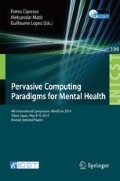Abstract
In this paper we present and discuss the design, implementation and evaluation of a visual programming environment. The proposed application allows authoring of therapeutic training sequences for the CareToy system, a hardware system developed for the purpose of in-home rehabilitation training for infants, aiming to improve the motor skills of preterm infants diagnosed with neurological conditions.
Access this chapter
Tax calculation will be finalised at checkout
Purchases are for personal use only
References
Hadders-Algra, M.: Early brain damage and the development of motor behavior in children: clues for therapeutic intervention? Neural Plast. 8(1–2), 31–49 (2001)
Blauw-Hospers, C.H., Hadders-Algra, M.: A systematic review of the effects of early intervention on motor development. Dev. Med. Child Neurol. 47(6), 421–432 (2005)
CareToy: A modular smart system for infants rehabilitation at home based on mechatronic toys, 05 March 2014. http://www.caretoy.eu
Cecchi, F., Serio, S.M., Del Maestro, M., Laschi, C., Sgandurra, G., Cioni, G., Dario, P.: Design and development of biomechatronic gym for early detection of neurological disorders in infants. In: 2010 Annual International Conference of the IEEE on Engineering in Medicine and Biology Society (EMBC), pp. 3414–3417 (2010)
Cono de la Cuerda, R., Munoz-Hellin, E., Alguacil-Diego, I.M., Molina-Rueda, F.: Telerehabilitation and neurology. Revista de Neurologia 51(1), 49–56 (2010)
Datta, C., Jayawardena, C., Kuo, I., MacDonald, B.: RoboStudio: a visual programming environment for rapid authoring and customization of complex services on a personal service robot. In: 2012 IEEE/RSJ International Conference on Intelligent Robots and Systems (IROS), pp 2352–2357 (2012)
Di Felice, P., Lochovsky, F.L., Mosser, T.: Officeaid VPE: a visual programming with examples system for specifying routine office tasks. J. Vis. Lang. Comput. 2(3), 275–296 (1991)
Diprose, J., MacDonald, B., Hosking, J.: Ruru: a spatial and interactive visual programming language for novice robot programming. In: 2011 IEEE Symposium on Visual Languages and Human-Centric Computing (VL/HCC), pp. 25–32 (2011)
Figl, K., Derntl, M., Caeiro Rodriguez, M., Botturi, L.: Cognitive effectiveness of visual instructional design languages. J. Vis. Lang. Comput. 21(6), 359–373 (2010)
Kiper, J.D., Howard, E., Ames, C.: Criteria for evaluation of visual programming languages. J. Vis. Lang. Comput. 8(2), 175–192 (1997)
Mason, D.: Data programming for non-programmers. Procedia Comput. Sci. 21, 68–74 (2013)
Myers, B.A.: Taxonomies of visual programming and program visualization. J. Vis. Lang. Comput. 1(1), 97–123 (1990)
Resnick, M., Maloney, J., Monroy-Hernandez, A., Rusk, N., Eastmond, E., Brennan, K., Millner, A., Rosenbaum, E., Silver, J., Silverman, B., Kafai, Y.: Scratch: programming for all. Commun. ACM 52(11), 60–67 (2009)
Whitley, K.N.: Visual programming languages and the empirical evidence for and against. J. Vis. Lang. Comput. 8(1), 109–142 (1997)
Lewis, J.R.: IBM Computer usability satisfaction questionnaires: psychometric evaluation and instructions for use. Int. J. Hum.-Comput. Interact. 7(1), 57–78 (1995)
Acknowledgments
The work presented in this paper is part of the CareToy project (www.caretoy.eu), funded by the European Union (ICT-2011.5.1-287932).
Author information
Authors and Affiliations
Corresponding author
Editor information
Editors and Affiliations
Rights and permissions
Copyright information
© 2014 Institute for Computer Sciences, Social Informatics and Telecommunications Engineering
About this paper
Cite this paper
Richter, E., Mici, L., Hendrich, N., Zhang, J. (2014). Design of Therapeutic Training Sequences for Infants Using a Visual Approach. In: Cipresso, P., Matic, A., Lopez, G. (eds) Pervasive Computing Paradigms for Mental Health. MindCare 2014. Lecture Notes of the Institute for Computer Sciences, Social Informatics and Telecommunications Engineering, vol 100. Springer, Cham. https://doi.org/10.1007/978-3-319-11564-1_15
Download citation
DOI: https://doi.org/10.1007/978-3-319-11564-1_15
Published:
Publisher Name: Springer, Cham
Print ISBN: 978-3-319-11563-4
Online ISBN: 978-3-319-11564-1
eBook Packages: Computer ScienceComputer Science (R0)

